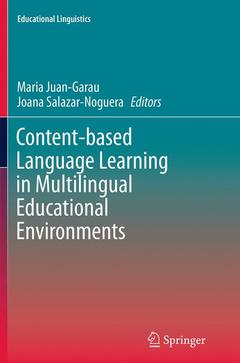Description
Content-based Language Learning in Multilingual Educational Environments, 2015
Educational Linguistics Series, Vol. 23
Coordinators: Juan-Garau Maria, Salazar-Noguera Joana
Language: English
Subject for Content-based Language Learning in Multilingual...:
Keywords
Content-based language learning in multilingual environments; Different educational approaches to multlingualism; Does CLIL enhance fluency; Implementing CLIL in education; Learning English and learning through English; Lexico-grammatical development in secondary edu CLIL learners; Research on CLIL; the role of CLIL; learning and instruction
Publication date: 09-2016
Support: Print on demand
Publication date: 11-2014
255 p. · 15.5x23.5 cm · Hardback
Description
/li>Contents
/li>Comment
/li>
The spread of English as an international language along with the desire to maintain local languages lead us to consider multilingualism as the norm rather than the exception. Consequently, bi/multilingual education has bloomed over the last decades. This volume deals with one such type of education currently in the spotlight as an essentially European strategy to multilingualism, CLIL (Content and Language Integrated Learning), in which curricular content is taught through a foreign language. The book contributes new empirical evidence on its effects on linguistic and attitudinal outcomes focusing on bi/multilingual learners who acquire English as an additional language. Moreover, it presents critical analyses of factors influencing multilingual education, the effects of CLIL on both language and content learning, and the contrast between CLIL and other models of instruction. The research presented suggests that CLIL can greatly enhance language acquisition in multilingual settings.
Introduction: The Relevance of CLIL Education in Achieving Multilingualism on the Global Stage.- Part I Towards Multilingualism through CLIL.- Different Educational Approaches to Bi/Multilingualism and their Effect on Language Attitudes.- Languages for all in Education: CLIL and ICLHE at the Crossroads of Multilingualism, Mobility and Internationalism.- The Effects of Implementing CLIL in Education.- Influences of Previously Learned Languages on the Learning and use of Additional Languages.- Time and Timing in CLIL: A Comparative Approach to Language Gains.- Part II Research on CLIL Education in Multilingual Settings.- Learning English and Learning through English: Insights from Secondary Education.- Testing Progress on Receptive Skills in CLIL and non-CLIL Contexts.- Writing Development under CLIL Provision.- Does CLIL Enhance Oral Skills? Fluency and Pronunciation Errors by Spanish-Catalan Learners of English.- Lexico-Grammatical Development in Secondary Education CLIL Learners.- Exploring Affective Factors in L3 Learning: CLIL vs. Non-CLIL.- English Learners’ Willingness to Communicate and Achievement in CLIL and Formal Instruction Contexts.- CLIL in Context: Profiling Language Abilities.




